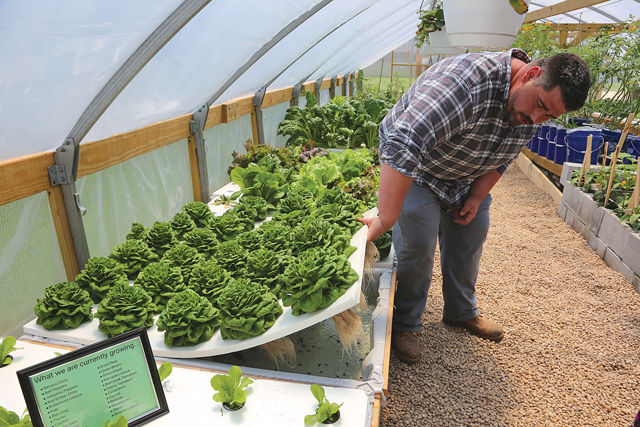Greenport’s school greenhouse advances agricultural learning, access to fresh food


School district officials unveiled Greenport’s first-ever outdoor greenhouse Friday to grow and harvest “hundreds of pounds” of fresh produce, officials said.
The 20-by-50-foot structure west of the school building was created with help from a New York State Farm to School grant which offered $68,820 to districts on the East End in 2018 to improve access to fresh food.
Financial support from State Senator Ken LaValle and donations from Jamesport farmer Carl Gabrielsen of Gabrielsen Farms helped build the greenhouse. Mr. LaValle and Mr. Gabrielsen attended the ribbon-cutting ceremony to unveil the greenhouse.
Roughly six years ago, Mr. Gabrielsen said, his business started donating underused greenhouses to local school districts including Mattituck and Southold.
His inability to grow fruits and vegetables in the offseason motivated him to explore hydroponic growing systems — a method of growing plants in a water-based solution, he said. After working with the University of Arizona, he invited 16 local school districts to the farm. At that time, most of the districts implemented agriculture into their curriculum, he said.
In October 2018, Mr. Gabrielsen donated the “bare bones” of a greenhouse to Greenport, Superintendent David Gamberg said.
Later that month, technology teacher Mike Davies began working with the high school and middle school Design, Drawing and Production class to construct the exterior, electrical wiring and plumbing within the greenhouse. All 25 varieties of herbs, veggies and flowers were seeded April 15, Mr. Davies said.
The hydroponic system used in the greenhouse is similar to a system unveiled inside the school earlier this year, also manufactured by the DDP class, Mr. Davies said.
“We learned from that,” he said. “The difference is, I didn’t want to add a lot of work … to maintain it. All of our [plant] beds, we water once, so there’s no upkeep. It just sits in there, it drinks it, and then we fill it back up.”
The greenhouse also features conventional farming with soil and self-watering systems, which maintains damp soil for longer periods, he said.
Stony Brook University professor Roxanne Zimmer, a Slow Food East End master farmer and Cornell Cooperative Extension master gardener, who consulted with teachers to make suggestions about agricultural learning in the district, said the agriculture program at Greenport allows students to understand the importance of nutrition.
“Ask a kid if he or she likes kale? No way. But if he or she grows the kale, ‘That’s my kale, and I grew this!’ There’s that wonderful relationship between farmer and food.”
Mr. Gabrielsen said he believes the future of farming is hydroponics: it allows for year-round growth.
“It’s the next step worldwide, it’s all over Europe,” he said. “Everything is a global market now. It can ship anywhere. So it’s hard for a farmer to grow outside, only be able to grow six months out of the year — you can’t survive anymore,” he said. “You have to change, and that’s what they’re doing.”
Mr. LaValle said the greenhouse is a powerful learning tool for students.
“Having been a former educator, I believe in an experiential curriculum, and this is it,” he said. “This is all part of our East End heritage.”
Caption: Greenport High School technology teacher Mike Davies explains the hydroponics system in the school’s new greenhouse following the May 31 unveiling. (Credit: Kate Nalepinski)








